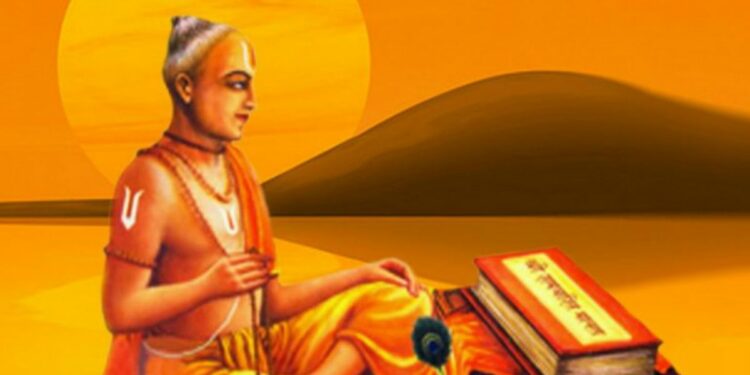Goswami Tulasidasa was entirely dedicated to his Ista Deva, Bhagavana Rama and Ramacarita Manasa composed by him, was the mission of his incarnation as mandated by Param Brahma. He was born as Rambola Dubey during sixteenth century because he uttered “Rama, Rama” immediately after birth which stupefied his young parents. Journey of transformation from Rambola to Tulasidasa has been full of severe austerities yet he succeeded on every front being endowed with blessings of his Ista Deva, Sri Rama.
Sri Ramacarita Manasa was composed when Hinduism was under severe challenges from foreign invaders, conversion of faith under coercion was in vogue and Hindu-s were being oppressed ruthlessly. The epic narration was composed in the city of Kasi in the form of Caupai of common vernacular and the entire narration of Sri Rama’s heroic deeds revolves around incessant Bhakti unto Sri Rama. It may well be declared as Upanisad in vernacular for common folks. Being Rambola himself to begin with in life, he established centrality of Rama Nama being greater than even Sri Rama. The epic is a monumental creation of Bhakti Yoga intended to consolidate and nourish roots of Sanatana Hinduism under enormous strain during that segment of history. On the contrary, Ramayana of Maharsi Valmiki adores Sri Rama on His virtues. Sri Rama is a live embodiment of Sat, Cit and Ananda, rather Param Brahma in human manifest. The great poet discovered his Ista Deva in Sri Rama and his quest for the Absolute One was satiated in Him. Every fragment of Sri Ramacarita Manasa is embodiment of his intense Bhakti for Sri Rama and the ultimate anchor to rely upon which he held stoutly. Tulasidasa also established and sanctified incessant Japa of Sri Rama as the easiest and most potent means to ultimate salvation. As one of the greatest Bhakti-Poets of contemporary history, Goswami Tulasidasa established primacy of Japa of Rama Nama as a potent means to ultimate salvation.
Legend has it that Hanumanji used to come and attend his everyday evening discourse on Sri Rama. After Hanumanji was identified by a ghost dwelling on an Aswattha tree at whose roots Tulasidasa used to dedicate Jala every morning after bathing in Ganga, he prayed and implored Hanumanji to facilitate Darsana of his Ista Deva. Hanumanji told Tulasidasa to first excavate His idol buried under the ground whereupon Tulasidasa used to conduct his evening discourses. The idol was dug out and consecrated there itself in a make-shift temple which later, became famous Sankata Mocaka Mandir in Varanasi, now visited by thousands of devotees every day. Goswami Tulasidasa had been praying and imploring Hanumanji to ensure Darsana of Sri Rama for him. When Sri Rama finally appeared before him, he could not recognise him at all and Tulasidasa continued imploring Hanumanji for the same. When Sri Rama appeared for the second time, Tulasidasa discovered himself languishing in utter disbelief !! How could He be Sri Rama Himself ?? Hanumanji reappeared to convince him to that effect and thus, Tulasidasa was ultimately redeemed into eternity.
Entire episode is immersed in intense mysticism. From a Bhakta to Jijnasu, then into a Mumuksu, his evolutionary transformation was complete. Even as an ardent Bhakta of Sri Rama, Tulasidasa had not been able to slash the veil of Maya successfully which manifested in his ignorant refusal to believe, the Isvara standing before him smilingly was Sri Rama Himself !! Hanumanji had to don upon Himself the role of a Siddha Guru, appeared before him and goaded Tulasidasa to believe, He was Sri Rama Himself. At the inspiration and prompting of his Guru Hanumanji, Goswami Tulasidasa succeeded in slashing the final veil of Maya with the sword of Jnana and redeemed himself in the lotus feet of his Ista Deva, Sri Rama. The episodic personal encounter of Tulasidasa with his Ista Deva Sri Rama was a real life enactment of entire Vedanta Darsana before all. Param Brahmatma is the sole, complete, perfect and unique Absolute Entity while Jivatma is a mere reflection of that comprising of Sat and Cit alone, devoid of Ananda. Param Brahmatma is Sat, Cit and Ananda too, thus perfect and complete. Atma, an aggregate of Sat and Cit, devoid of Ananda is always craving incessantly and restlessly to attain Ananda so as to be perfect with all the three i.e. Sat, Cit and Ananda, to be at peace with itself ultimately. Cosmic journey through Maya is completed instantly the moment Ananda is attained by Atma. Then nothing worthwhile is left behind to be attained by Atma. The mystical episode also reveals indispensable nature of Guru’s role in the ultimate attainment. Guru’s facilitation and mentoring are monumental, inevitable and immutable.
It also reveals yet another cosmic reality. Sri Rama alone is real Atma i.e. Self of all. Sri Rama alone is the beginning point of existence of every Jivatma. Line of demarcation between Sri Rama, The Universal and Sri Rama, The Atma is the wall and veil of Ahamkara alone. An infinite ocean of existence opens up no sooner the wall and veil of this Ahamkara is smashed into smithereens with the spear of Jnana. That is the ultimate glorious moment of redemption in the cosmic journey of every Jivatma.


















Discussion about this post